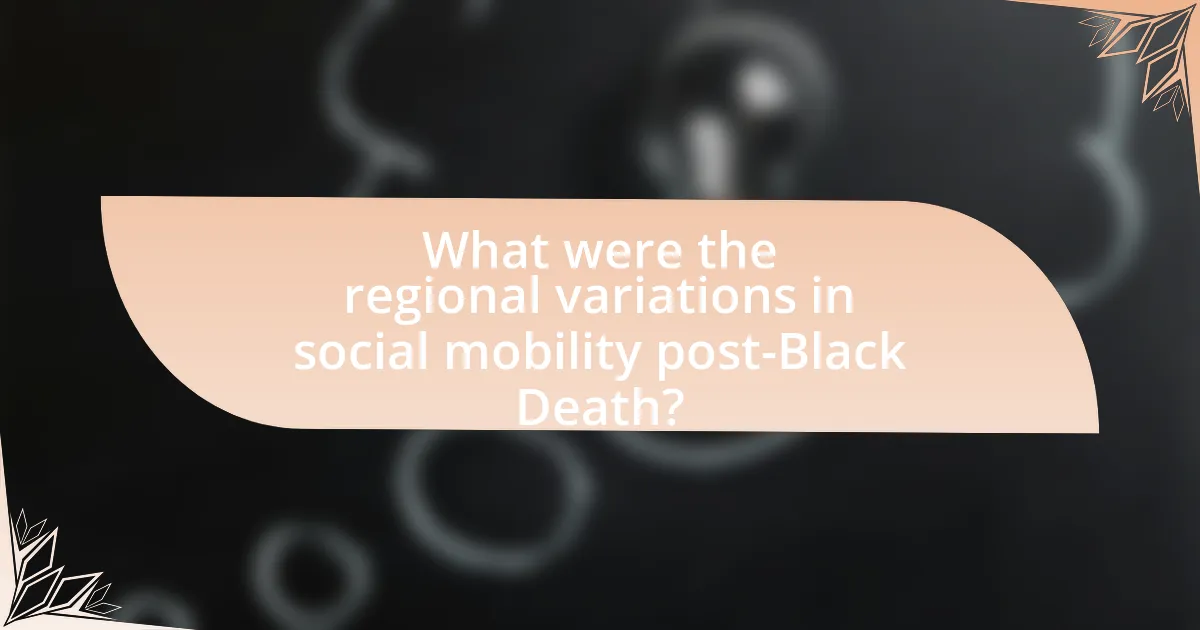The article examines the profound impact of the Black Death on social mobility during the Middle Ages, specifically between 1347 and 1351. It details how the pandemic, caused by the bacterium Yersinia pestis, led to the deaths of approximately 25 million people in Europe, resulting in significant labor shortages. This demographic shift empowered surviving workers to demand higher wages and better working conditions, ultimately challenging the existing feudal system and facilitating upward mobility for lower classes. The article also explores regional variations in social mobility, the emergence of new social classes, and the long-term effects on social structures, highlighting the transformative nature of this historical event.

What was the Black Death and its historical context?
The Black Death was a devastating pandemic that struck Europe between 1347 and 1351, caused primarily by the bacterium Yersinia pestis, which was transmitted through fleas and rats. This catastrophic event led to the deaths of an estimated 25 million people, roughly one-third of Europe’s population at the time, significantly altering the social and economic landscape of the continent. The historical context of the Black Death includes a period of social stratification and feudalism, where the majority of the population were peasants bound to the land. The massive death toll resulted in labor shortages, which empowered surviving workers to demand higher wages and better working conditions, ultimately contributing to shifts in social mobility during the Middle Ages.
How did the Black Death spread across Europe?
The Black Death spread across Europe primarily through fleas that infested rats, which were common on merchant ships and in urban areas. As trade routes expanded in the 14th century, the movement of goods and people facilitated the transmission of the plague from Asia to Europe, with the first recorded outbreak occurring in Sicily in 1347. Historical records indicate that within a few years, the disease had traversed the continent, leading to the deaths of an estimated 25 million people, or about one-third of Europe’s population at the time. This rapid spread was exacerbated by the lack of medical knowledge and poor sanitation practices, allowing the disease to proliferate unchecked in crowded cities and towns.
What were the primary causes of the Black Death’s rapid spread?
The primary causes of the Black Death’s rapid spread were the movement of infected fleas on rats, human-to-human transmission, and the lack of medical knowledge. The bacterium Yersinia pestis, carried by fleas, thrived in the crowded and unsanitary conditions of medieval towns, facilitating its spread. Additionally, trade routes, such as the Silk Road, enabled the disease to travel quickly across regions. Historical records indicate that the plague reached Europe in 1347 through ships arriving from Asia, leading to widespread outbreaks. The absence of effective public health measures further exacerbated the situation, allowing the disease to proliferate unchecked.
What regions were most affected by the Black Death?
The regions most affected by the Black Death were Europe, particularly Italy, France, and England. The pandemic, which struck in the mid-14th century, resulted in the deaths of an estimated 25 million people in Europe, significantly reducing the population and altering social structures. Italy, as a major trade hub, experienced some of the earliest and most severe outbreaks, while France and England followed closely behind, with mortality rates reaching as high as 60% in certain areas. This drastic population decline led to increased social mobility as labor shortages empowered surviving workers to demand better wages and conditions.
What were the immediate social impacts of the Black Death?
The immediate social impacts of the Black Death included a significant reduction in the population, leading to labor shortages and increased social mobility for surviving workers. The death toll, estimated to be between 25 million and 30 million people in Europe, resulted in a dramatic shift in the labor market. With fewer workers available, those who survived could demand higher wages and better working conditions, challenging the existing feudal system. This shift contributed to the decline of serfdom and allowed for greater opportunities for peasants to improve their social status, as landowners sought to attract labor by offering more favorable terms.
How did the population decline affect labor availability?
The population decline during the Black Death significantly reduced labor availability. As the death toll reached an estimated 25 million people in Europe, the workforce shrank drastically, leading to labor shortages in various sectors. This scarcity of labor empowered surviving workers to demand higher wages and better working conditions, fundamentally altering the dynamics of labor relations in the Middle Ages. Historical records indicate that wages for agricultural laborers increased by as much as 50% in some regions, illustrating the direct correlation between population decline and labor availability.
What changes occurred in the social hierarchy due to the Black Death?
The Black Death significantly altered the social hierarchy by diminishing the population, which led to a labor shortage and increased bargaining power for surviving workers. As a result, peasants and laborers could demand higher wages and better working conditions, challenging the traditional feudal system. Historical records indicate that after the plague, many serfs gained freedom and land, as landowners sought to retain laborers by offering them more favorable terms. This shift marked the beginning of the decline of feudalism and the rise of a more fluid social structure, where wealth and status became increasingly tied to economic power rather than noble birth.

How did the Black Death influence social mobility?
The Black Death significantly increased social mobility by creating labor shortages that empowered surviving workers to demand higher wages and better working conditions. As a result of the pandemic, which killed an estimated one-third of Europe’s population between 1347 and 1351, many feudal lords struggled to maintain their estates due to a lack of labor. This shift allowed peasants and laborers to negotiate terms that were previously unattainable, leading to a gradual decline in the rigid class structure of medieval society. Historical records indicate that some peasants were able to purchase their freedom or land, further illustrating the transformative impact of the Black Death on social hierarchies.
What opportunities for social mobility arose after the Black Death?
After the Black Death, significant opportunities for social mobility emerged primarily due to the drastic reduction in the population, which led to labor shortages. This scarcity allowed surviving peasants and laborers to demand higher wages and better working conditions, as landowners needed to attract workers to maintain agricultural production. Historical records indicate that many serfs were able to negotiate their freedom or move to towns where they could find better-paying jobs, thus improving their social status. For instance, the Statute of Laborers in 1351 attempted to limit wage increases, but it was largely ineffective due to the persistent demand for labor. Consequently, the aftermath of the Black Death facilitated a shift in the social hierarchy, enabling upward mobility for those who previously had limited opportunities.
How did the labor shortage empower lower classes?
The labor shortage following the Black Death empowered lower classes by increasing their bargaining power and enabling them to demand higher wages and better working conditions. As a significant portion of the workforce perished, the remaining laborers became scarce, leading to a shift in the economic balance. Historical records indicate that wages for agricultural laborers rose by as much as 50% in some regions, reflecting the increased demand for their services. Additionally, many peasants were able to negotiate for more favorable terms, including the ability to leave their manors and seek employment elsewhere, which was previously restricted. This newfound mobility and economic leverage allowed lower classes to improve their social standing and challenge the existing feudal hierarchy.
What role did land ownership play in social mobility during this period?
Land ownership significantly enhanced social mobility during the period following the Black Death. The catastrophic decline in population led to a labor shortage, which increased the value of land and provided opportunities for lower-class individuals to acquire property. Many peasants, previously bound to the land as serfs, gained the ability to negotiate better terms or purchase land, thus elevating their social status. Historical records indicate that land ownership shifted from the nobility to a broader base of the population, allowing former serfs to become landowners and, consequently, members of the emerging middle class. This transformation was pivotal in reshaping the social hierarchy of the time.
What were the long-term effects of the Black Death on social structures?
The long-term effects of the Black Death on social structures included a significant shift in social mobility and the decline of feudalism. The massive population loss, estimated at 30-60% of Europe’s population, created labor shortages that empowered surviving workers to demand higher wages and better working conditions. This shift led to the erosion of the rigid class structures that characterized feudal society, as peasants gained more negotiating power and some even transitioned to landownership. Additionally, the increased wealth of the lower classes contributed to the rise of a more market-oriented economy, further diminishing the traditional feudal hierarchy. Historical records indicate that by the late 14th century, many peasants had improved their social standing, illustrating the transformative impact of the Black Death on social structures in medieval Europe.
How did the Black Death contribute to the decline of feudalism?
The Black Death significantly contributed to the decline of feudalism by drastically reducing the population, which led to labor shortages and increased bargaining power for peasants. As the plague swept through Europe in the 14th century, it is estimated that up to one-third of the population perished, resulting in a diminished workforce. This scarcity of labor forced landowners to offer better wages and conditions to attract workers, undermining the traditional feudal obligations that bound peasants to their lords. Consequently, many serfs began to leave their manors in search of better opportunities, further eroding the feudal system. Historical records indicate that the Statute of Laborers in 1351 attempted to curb wage increases, but it was largely ineffective due to the persistent demand for labor. Thus, the demographic and economic shifts caused by the Black Death played a crucial role in weakening feudal structures and promoting social mobility.
What new social classes emerged as a result of the Black Death?
The Black Death led to the emergence of new social classes, particularly a more empowered peasantry and a rising merchant class. The drastic population decline resulted in labor shortages, which increased the bargaining power of surviving workers, allowing them to demand higher wages and better working conditions. This shift contributed to the decline of the feudal system, as many peasants transitioned from serfdom to paid labor, thus forming a more distinct and economically independent class. Additionally, the increased wealth of merchants, who capitalized on the changing economic landscape, solidified their status as a new social class with significant influence.

What were the regional variations in social mobility post-Black Death?
Post-Black Death, regional variations in social mobility were significant, with areas like England experiencing upward mobility for peasants due to labor shortages, while regions in Southern Europe, such as Italy, saw less change due to stronger feudal structures. In England, the death of a large portion of the population led to increased wages and better living conditions for surviving laborers, as evidenced by the Statute of Laborers in 1351, which attempted to limit wage increases. Conversely, in Southern Europe, the persistence of established aristocratic power and land ownership restricted social mobility, maintaining the status quo despite the demographic shifts caused by the plague.
How did different regions in Europe respond to the changes in social mobility?
Different regions in Europe responded to changes in social mobility after the Black Death with varying degrees of adaptation and transformation. In England, for instance, the labor shortage caused by the plague led to increased wages for peasants and a decline in the feudal system, allowing for greater social mobility. Conversely, in parts of France, the nobility attempted to maintain their power by enforcing laws that restricted wage increases and limited the movement of laborers, thereby stifling social mobility. In Italy, urban areas experienced a rise in merchant classes and a shift towards a more dynamic economy, which facilitated upward mobility for some individuals. These regional responses illustrate how the Black Death catalyzed significant social changes, with some areas embracing new opportunities while others resisted them.
What factors influenced the rate of social mobility in urban versus rural areas?
The rate of social mobility in urban versus rural areas during the Middle Ages was influenced primarily by economic opportunities, access to education, and social structures. Urban areas, particularly after the Black Death, experienced a labor shortage that increased wages and allowed lower-class individuals to improve their social standing. In contrast, rural areas remained largely agrarian with limited economic mobility due to feudal obligations and a lack of diverse job opportunities. Historical data indicates that cities like Florence and London saw a rise in the merchant class, while rural populations faced stagnation, reinforcing the disparity in social mobility between these environments.
How did local governance affect social mobility in various regions?
Local governance significantly influenced social mobility in various regions during the Middle Ages, particularly following the Black Death. In areas where local authorities implemented policies that favored the redistribution of land and resources, such as in England, there was an observable increase in social mobility for the lower classes. For instance, the decline in the population due to the plague led to labor shortages, prompting local governments to raise wages and improve working conditions, which allowed serfs to negotiate better terms or even purchase their freedom. Conversely, in regions where local governance remained rigid and upheld feudal structures, such as parts of France, social mobility was limited, as the nobility retained control over land and resources, stifling opportunities for the lower classes. Historical records indicate that in England, the Statute of Laborers in 1351 attempted to curb wage increases, but the initial rise in wages and the ability of peasants to move for better opportunities marked a significant shift in social dynamics.
What lessons can be learned from the impact of the Black Death on social mobility?
The Black Death significantly increased social mobility by disrupting the feudal system and creating labor shortages. As a result, surviving peasants gained leverage to negotiate better wages and conditions, leading to a gradual decline in serfdom. Historical records indicate that after the plague, many laborers could demand higher pay due to the scarcity of workers, exemplified by the 1349 Statute of Laborers in England, which attempted to freeze wages but ultimately highlighted the shift in power dynamics. This event illustrates that crises can catalyze social change, allowing lower classes to ascend economically and socially when traditional structures are weakened.
How can historical insights inform our understanding of social mobility today?
Historical insights reveal that the Black Death significantly altered social mobility in the Middle Ages, providing a framework for understanding contemporary social mobility. The pandemic led to a drastic reduction in the population, which created labor shortages and increased the bargaining power of surviving workers. For instance, after the Black Death, many peasants were able to negotiate better wages and conditions, leading to a gradual decline in the feudal system and an increase in social mobility. This historical context illustrates how crises can disrupt existing social structures and create opportunities for upward mobility, a concept that remains relevant today as economic shifts and societal changes continue to influence social mobility patterns.
What strategies can modern societies adopt to enhance social mobility?
Modern societies can enhance social mobility by implementing comprehensive education reforms, improving access to quality healthcare, and promoting equitable economic opportunities. Education reforms, such as increasing funding for public schools and providing affordable higher education, can equip individuals with the skills necessary for upward mobility. For instance, countries like Finland have demonstrated that investing in education leads to higher social mobility rates. Access to quality healthcare ensures that all individuals can maintain their health and productivity, which is crucial for economic participation. Additionally, promoting equitable economic opportunities through policies like minimum wage increases and support for small businesses can help reduce income inequality, as evidenced by studies showing that countries with lower income inequality tend to have higher social mobility.